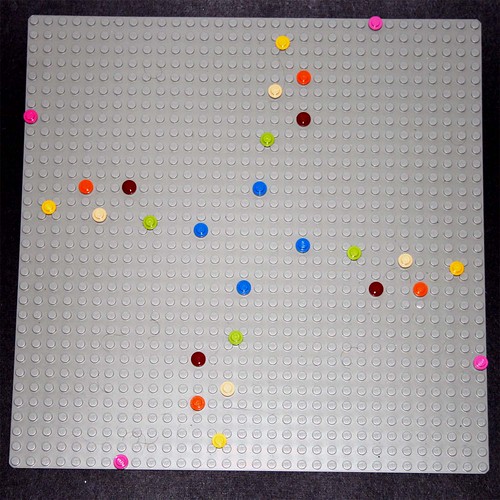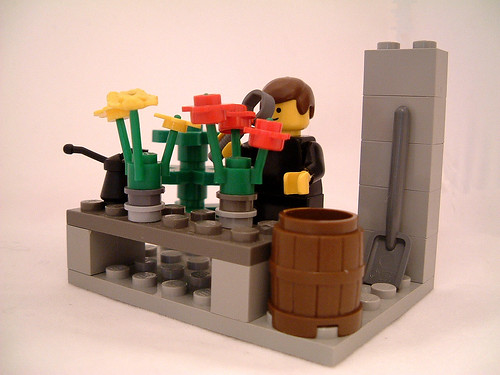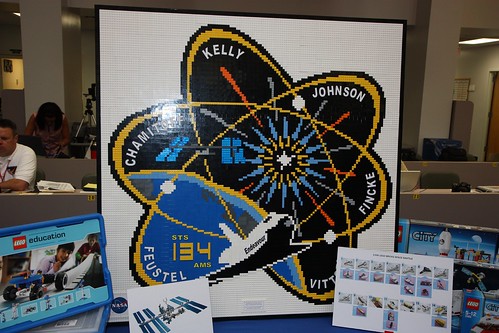
Tuesday, September 6, 2011
Chemistry Graduate School
About ten years ago I made a Chemistry Graduate School for my then-girlfriend-now-wife, who is also a chemist. I put this together like it was a line of small modular sets based on the design of the old Harry Potter sets (e.g. see Snape's Class and the Forbidden Corridor).


Friday, September 2, 2011
Albert Einstein
Around the turn of the last century it was believed that physics was pretty much a closed book, that Newtonian physics explained it all. Then in 1905 a humble patent inspector named Albert Einstein published four key papers based simply on sitting at his desk and thinking that revolutionized the face of science. To take one, "On a Heuristic Viewpoint Concerning the Production and Transformation of Light" (the basis for his 1921 Nobel prize) looks at a phenomenon that had not been explained before that point, the fact that electrons are ejected from a surface when you irradiate it with an appropriate wavelength of light. Einstein suggested that light could be described as both a wave and as discrete particles. This wave/particle duality forms one of the key elements of quantum mechanics. He realized that when you deal with very small amounts of energy, you find that it is quantized - that is, you cannot break it down into smaller units (just like matter can be broken down into smallest units). His other studies went on to revolutionize our understanding of matter, energy, gravity, magnetism, light, and the nature of space itself. It's no surprise that he has become the face of science and genius, and this huge bust can be found in Legoland Germany (there's a similar bust at Legoland California, and probably the other Legolands as well).


Wednesday, August 31, 2011
Bye-bye, figs!
Pcdos61 was there to watch the launch of the Juno probe (the one that is carrying three minifigs to Jupiter).


Wednesday, August 17, 2011
Fermat, well, no, Pythagoras
If Google is your home page (it's mine), you noticed this morning that today is the 410th anniversary of Fermat's birth. We all remember from high school geometry that the sum of the squares of the sides of a right trangle equals the sum of the hypotenuse, or a2 + b2 = c2, the Pythagorean theorem. Fermat famously came up with his 'last theorem', that this did not work for other powers, e.g. there are no positive integers that lead to a3 + b3 = c3. Unfortunately he didn't have space in the margin where he noted to give the proof. Or maybe that was fortunate, as it inspired the last few centuries of mathematicians to tackle this problem, until it was finally proven in 1995. I couldn't find any LEGO creations relevant to Fermat, but the Pythagorean theorem is useful in building with LEGO. You may think that LEGO is limited to square structures, but using pythagoras you can connect things at other angles, using 3/4/5 triangles, or 5/12/13, etc. For example:

Or you can see the lines here:

The late Erik Brok did some work on this using hinges:

and technic beams:

There's more discussion of how to use Pythagoras in LEGO building on various LEGO sites, like here, here and . Break away from the rigid rules of right angles!

Or you can see the lines here:

The late Erik Brok did some work on this using hinges:

and technic beams:

There's more discussion of how to use Pythagoras in LEGO building on various LEGO sites, like here, here and . Break away from the rigid rules of right angles!
Monday, August 15, 2011
What hath God wrought?
During the early 1800's there were a series of inventions designed to transmit messages over wires, leading up to the point where Morse developed his telegraph (here in LEGO by Monsterbrick) in 1837. This was the first step of the telecommunications revolution that brought the world together, leading up to the internet today.


Thursday, August 4, 2011
More on Juno
The Brothers Brick had some additional links on the figs going to Jupiter - the press releases are available from NASA and LEGO.
LEGO writes that "The LEGO crew’s mission is part of the LEGO Bricks in Space project, the joint outreach and educational programme developed as part of the partnership between NASA and the LEGO Group to inspire children to explore science, technology, engineering, and mathematics." and that information and activities will be found at LEGOspace.com.

BTW, looking closely at the figs, I notice that Galileo isn't just holding a simple ball, but instead it's engraved to look like Jupiter (you can see the swirling clouds and the great red spot).
LEGO writes that "The LEGO crew’s mission is part of the LEGO Bricks in Space project, the joint outreach and educational programme developed as part of the partnership between NASA and the LEGO Group to inspire children to explore science, technology, engineering, and mathematics." and that information and activities will be found at LEGOspace.com.

BTW, looking closely at the figs, I notice that Galileo isn't just holding a simple ball, but instead it's engraved to look like Jupiter (you can see the swirling clouds and the great red spot).
Wednesday, August 3, 2011
Minifigs headed to Jupiter
Three minifigs are headed for Jupiter! These three stowaways, representing Jupiter, Juno and Galileo, are affixed to the Juno space probe, which is launching in two days. The probe will arrive near Jupiter in July 2016. LEGO carved these out of solid aluminum to include in the probe. They only revealed this little detail at the last minute - I hope they actually make something out of this and produce these as plastic figs. I'd love to own an official Galileo fig.


Periodic Table of the Elements
Surely everyone recognizes the periodic table, posted on the wall of every chemistry classroom, but what does it mean and does that characteristic shape bear any meaning? Let's start with the basics - The world around you is made up of a little over 100 fundamental types of atoms, called elements. These elements are characterized by the number of protons in the nucleus - Hydrogen, the smallest element, has only one proton, Helium has two, Lithium has three, and so on. Mendeleev noticed that when you arrange these by increasing number of protons, there are repeating properties - every eighth element reacts in a similar way. It turns out, reaction patterns are related to the arrangement of electrons around the nucleus. These electrons are found in regions called orbitals. S orbitals hold two electrons, p orbitals hold six, d orbitals hold ten and f orbitals hold 14. Now take a close look at the table below. On the left=hand side is a block made of two columns, then a block colored blue made up of ten columns, then another block made of six columns, and down below is a white section made of fourteen columns. That's not accidental. Neutral atoms have an equal amount of protons and electrons, so Mendeleev's list could also be characterized by an increasing number of electrons. Reading from left to right and moving down the table line to line, the first two electrons are in s orbitals, the next two are also in s orbitals, then the next six electrons go into p orbitals, and so forth.


Sunday, July 31, 2011
Friday, July 29, 2011
Shuttle set rerelease
As part of a tribute to the end of the Space Shuttle program, LEGO is rereleasing set 10231, Shuttle Expedition. This is a fairly minor reworking of last year's set 10213, Shuttle Adventure. It's supposed to be a more sturdy design to be more play-able for younger kids.




Tuesday, July 26, 2011
Curiosity
Just because the Space Shuttle program is over doesn't mean NASA is shutting down. Our astronauts will continue to visit the International Space Station using other rockets, and a future manned program is in the works. More immediately, though, is the Curiosity (here built by Tim Goddard), an unmanned probe that will launch for Mars later this year. The Mars Space Laboratory's mission is to collect and analyze samples to see if Mars can, or has in the past, support any form of life.


Sunday, July 24, 2011
Doppler effect
Since sound travels as a wave, if you move the source of that sound, the waves will be pushed closer together (higher tone) or further apart (lower tone). This is the source of the doppler effect, as you can hear when a firetruck goes past, or in this rotating speaker by ISOGAWAYoshihito. This is also the source of the red shift that indicates that other galaxies are moving away from us.
Thursday, July 21, 2011
Welcome home, Atlantis
With the landing of the Atlantis, three decades of the Space Shuttle program draws to a close. It feels like I've been watching these things go up in the air for most of my life, so it's kind of a sad moment. Whither now, NASA? Remember when George Bush announced the next step for NASA was a trip to Mars? The NASA Authorization Act of 2010 provides for development of a new launch system, to ultimately move beyond Earth orbit in five years, but in the meantime our Astronauts will be riding Russian rockets up to the ISS, or else fly on commercial carriers. This Shuttle sculpture is from Legoland Windsor.


Wednesday, July 20, 2011
Happy birthday, Gregor
As anyone who visits Google knows, today is the 189th anniversary of the birth of Gregor Mendel (here in LEGO form by Kaptain Kobold). Mendel discovered the basic laws of genetics while observing the growth of pea plants. He noted that if two plants with purple flowers are crossed, the offspring has purple flowers. If two with white flowers are crossed, the offspring has white flowers. However, if a purple flowered plant is crossed with a white flowered plant, the offspring has purple flowers. While the molecular basis for this would not be discovered for fifty years, he correctly surmised that flower color is driven by a pair of factors, and there are dominant and recessive genes. He worked out the implications of how genes are mixed and matched in sexual reproduction, and is considered the father of genetics.

Just a quick apology for the month long hiatus in this blog. Life has been hectic lately.

Just a quick apology for the month long hiatus in this blog. Life has been hectic lately.
Saturday, June 18, 2011
Shinkai 6500
I previously noted the Japan-exclusive set 21100, Shinkai 6500. Builder Ocean-Storm made a number of modifications to make a more accurate model of the deep-sea explorer.


Thursday, June 16, 2011
Building in space
The other day I mentioned the LEGO sets sent to the International Space Station. While some of them are more fun, like a model of the ISS, some of them will be physics experiments. LEGO hasn't posted lesson plans yet, but students here on earth will build models to do simple experiments, like compare mass using a balance, and their results will compare to those performed in orbit, under conditions of microgravity.


Tuesday, June 14, 2011
STS-134
STS-134, which landed recently, was the next to last Space Shuttle mission. One fun aspect of this mission was the launch (literally) of a partnership between LEGO and NASA. A set of LEGO models was brought up on the Shuttle to the International Space Station as part of an interactive project to get grade school kids excited about science. This actually isn't the first such partnership, but more on that at another time.


Sunday, June 12, 2011
Friday, June 10, 2011
Wednesday, June 8, 2011
MRI
MRI, or Magnetic Resonance Imaging, is based on the same principles as NMR (Nuclear Magnetic Resonance) (they changed the name out of concern that patients wouldn't come near something 'nuclear'). Hydrogen atoms have a very small magnetic moment. Normally, these magnetic moments are completely random and cancel out. When placed in a strong external magnetic field, these hydrogen nuclei align either with or against the external field. When these are pulsed with radio wave energy, the tiny atomic magnetic moments flip from low energy state, to high energy state, and then relax back to the low energy state. Since the body is full of water molecules, mapping out the location and density of these molecules (or, more properly, the hydrogen atoms in the H2O), doctors can get a peek inside your skin.


Subscribe to:
Posts (Atom)


